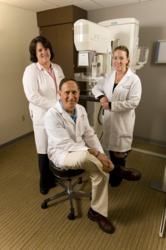Susquehanna Health Ahead of the Curve with Breast Density Cancer Screenings

Williamsport, PA (PRWEB) December 02, 2011
Research published recently in the Journal of Clinical Oncology (JCO) and the Journal of the National Cancer Institute (JNCI) identifies breast density as being associated with an increased risk of breast cancer in post-menopausal women. These types of cancers are also noted to be more aggressive. Although reported findings are new, physicians at Susquehanna Health (SH) have been acting on this principle for nearly a decade. Based on data and our experience, we instigated a screening process using whole breast ultrasound about seven years ago. So, we are way ahead of the curve, said Dr. Timothy Pagana, Medical Director of the SH Kathryn Candor Lundy Breast Health Center. We have been very impressed by a marked increase in breast cancer detection in women who have had normal mammograms.
Recently, Dr. Pagana has been educating women in the north central Pennsylvania region about breast density, the increased risk for breast cancer and whole breast ultrasound and in October was a keynote speaker for the SH Spirit of Women program in Williamsport, PA. Breast density refers to proportions of glands, ducts and fatty tissue in the breast. Density is divided into four categories: 1) entirely fat (very little density); 2) scattered fibro glandular densities (minimal density); 3) heterogeneously dense (moderate density); and 4) extremely dense.
According to Dr. Pagana, glands and ducts that cause density will appear as white on a mammogram. In contrast, the fat content of a breast appears dark on a mammogram. As a women reaches menopause, the breasts should go through a process referred to as involution in which glands and ducts are replaced by fatty tissue. The risk factor for women who are post-menopausal with extremely dense breast tissue is four times higher than the general population for developing cancer, according to Dr. Pagana.
Breast density creates an obstacle for accurately identifying cancer with a traditional examination and mammography and is a warning sign for increased cancer risk in post-menopausal women. If breast tissue doesnt diminish [with menopause], there is something else going on that is causing the glandular tissue to continue and the breast tissue to appear dense, Dr. Pagana explained. As a result of the density, the chance of finding cancer using traditional mammography is reduced while the risk of cancer is increased. In comparison, when fatty tissue replaces glands and ducts as expected and breast tissue becomes less dense, traditional mammograms are easier to read. Our concern is for those women for whom involution doesnt occur, said Dr. Pagana.
Whole breast ultrasound is helpful in identifying breast abnormalities because the ultrasound waves are capable of pinpointing smaller cancers even in very dense breast tissue. The addition of this type of ultrasound testing for women with dense breast tissue increases the chance that even small breast cancers are identified, treated and cured. Whole breast ultrasound is the best way to go because it provides adequate sensitivity and specificity. It is the least aggressive and most cost effective way to screen for breast cancer, explained Dr. Pagana.
Ultrasound technologists at the Kathryn Candor Lundy Breast Health Center are experienced and dedicated to the art and science of reading whole breast ultrasounds. Although MRI may be more sensitive, it is less specific, according to Dr. Pagana. Furthermore, MRI is more costly. The Breast Health Center is in the process of purchasing a state-of-the-art whole breast ultrasound machine capable of scanning breast tissue micrometer by micrometer, collecting and compiling data and producing a movie-like scan of images.
In general, women over the age of 40 are encouraged to have an annual mammogram. Following a mammogram, a patient should be provided the result of their mammogram and informed about the density of their breast tissue. If density is not mentioned in the report, the patient should ask that the mammogram be re-read to provide an accurate assessment of breast density. When breast density is determined to be moderately (50 to 75 percent) or extremely dense (75 to 100 percent), whole breast ultrasound at an experienced center should be recommended.
Additional imaging is also recommended for women who are considered high risk due to such things as family history of breast cancer, use of hormone therapy, a BRCA genetic mutation or premalignant tissue changes on a prior breast biopsy. For additional information on breast density or the Kathryn Candor Lundy Breast Health Center, please call 570-326-8200.
About Susquehanna Health
Susquehanna Health is a three-hospital integrated health system including Divine Providence Hospital, Muncy Valley Hospital and Williamsport Regional Medical Center located in northcentral Pennsylvania. Serving patients from an 11-county region, Susquehanna Health is a healthcare leader and has been recognized at the national and state levels for quality of care. Susquehanna Health offers a wide array of services that include cancer treatment, heart and vascular care/heart surgery, neurosciences including neurosurgery, orthopedics, urology, OB/GYN, gastrointestinal services, behavioral health, physical rehabilitation, home care, long term care, assisted living and paramedic/ambulance services.
###
